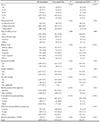References
1. Lee S, Jee SH. World Health Organization's recommendation on heat-not-burn tobacco products and its' application to Korea. J Korean Soc Res Nicotine Tob 2017;8(2):55–57.
5. Simonavicius E, McNeill A, Shahab L, Brose LS. Heat-not-burn tobacco products: a systematic literature review. Tob Control 2019;28(5):582–594.
6. Auer R, Concha-Lozano N, Jacot-Sadowski I, Cornuz J, Berthet A. Heat-not-burn tobacco cigarettes: smoke by any other name. JAMA Intern Med 2017;177(7):1050–1052.
7. Sutanto E, Miller C, Smith DM, O'Connor RJ, Quah ACK, Cummings KM, et al. Prevalence, use behaviors, and preferences among users of heated tobacco products: findings from the 2018 ITC Japan Survey. Int J Environ Res Public Health 2019;16(23)4630.
8. Czoli CD, White CM, Reid JL, OConnor RJ, Hammond D. Awareness and interest in IQOS heated tobacco products among youth in Canada, England and the USA. Tob Control 2020;29(1):89–95.
9. Tabuchi T, Kiyohara K, Hoshino T, Bekki K, Inaba Y, Kunugita N. Awareness and use of electronic cigarettes and heat-not-burn tobacco products in Japan. Addiction 2016;111(4):706–713.
10. Kang H, Cho SI. Heated tobacco product use among Korean adolescents. Tob Control 2019;1. 1. [Epub ahead of print].
11. Kim J, Yu H, Lee S, Paek YJ. Awareness, experience and prevalence of heated tobacco product, IQOS, among young Korean adults. Tob Control 2018;27Suppl 1. :S74–S77.
14. Lee C, Kim S, Cheong YS. Issues of new types of tobacco(e-cigarette and heat-not-burn tobacco): from the perspective of ‘tobacco harm reduction’. J Korean Med Assoc 2018;61(3):181–190.
15. Ahn HK, Lee HJ, Jung DS, Lee SY, Kim SW, Kang JH. The reliability and validity of Korean version of questionnaire for nicotine dependence. J Korean Acad Fam Med 2002;23(8):999–1008.
16. Wu YS, Wang MP, Ho SY, Li HCW, Cheung YTD, Tabuchi T, et al. Heated tobacco products use in Chinese adults in Hong Kong: a population-based cross-sectional study. Tob Control 2019;04. 20. [Epub ahead of print].
17. Khang YH, Cho HJ. Socioeconomic inequality in cigarette smoking: trends by gender, age, and socioeconomic position in South Korea, 1989-2003. Prev Med 2006;42(6):415–422.
18. Lee Y, Lee KS. Factors related to smoking status among young adults: an analysis of younger and older young adults in Korea. J Prev Med Public Health 2019;52(2):92–100.
19. Wang Q, Shen JJ, Sotero M, Li CA, Hou Z. Income, occupation and education: are they related to smoking behaviors in China? PLoS One 2018;13(2)e0192571.
20. Hair EC, Bennett M, Sheen E, Cantrell J, Briggs J, Fenn Z, et al. Examining perceptions about IQOS heated tobacco product: consumer studies in Japan and Switzerland. Tob Control 2018;27Suppl 1. :s70–s73.
21. McKelvey K, Popova L, Kim M, Chaffee BW, Vijayaraghavan M, Ling P, et al. Heated tobacco products likely appeal to adolescents and young adults. Tob Control 2018;27Suppl 1. :s41–s47.
22. Okechukwu CA, Nguyen K, Hickman NJ. Partner smoking characteristics: associations with smoking and quitting among blue-collar apprentices. Am J Ind Med 2010;53(11):1102–1108.
23. Joung MJ, Han MA, Park J, Ryu SY. Association between family and friend smoking status and adolescent smoking behavior and E-cigarette use in Korea. Int J Environ Res Public Health 2016;13(12)1183.
25. Hackshaw A, Morris JK, Boniface S, Tang JL, Milenković D. Low cigarette consumption and risk of coronary heart disease and stroke: meta-analysis of 141 cohort studies in 55 study reports. BMJ 2018;360j5855.
26. Zhou X, Nonnemaker J, Sherrill B, Gilsenan AW, Coste F, West R. Attempts to quit smoking and relapse: factors associated with success or failure from the ATTEMPT cohort study. Addict Behav 2009;34(4):365–373.
27. Lee JS, Kang SM, Kim HJ, Lee KY, Cho B, Goh E. Long-term maintenance of smoking cessation and related factors of relapse. Korean J Fam Med 2009;30(3):203–209.
28. Bold KW, Rasheed AS, McCarthy DE, Jackson TC, Fiore MC, Baker TB. Rates and predictors of renewed quitting after relapse during a one-year follow-up among primary care patients. Ann Behav Med 2015;49(1):128–140.
29. Cho HJ. Issues related to e-cigarettes use. J Korean Soc Res Nicotine Tob 2016;7(2):61–65.


